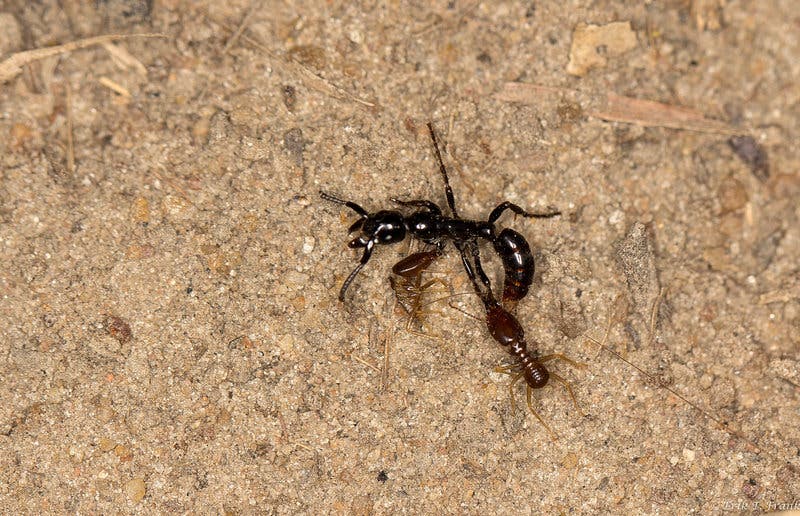The ant Megaponera analis may not be the friendliest creature — after all, it relies solely on raiding termites — but it does take care of its comrades, and they never leave an injured soldier behind.
Ants vs termites

If the natural world was split into goodies and baddies, the Megaponera would almost certainly be the baddies. They hunt, kill, and eat termites for nutrients. Scouts initially go out and locate the termites, and then return to call the troops.
The entire march and attack are pretty gruesome. Biologist Erik Frank explains that 200 to 500 ants will march out in formation, prepared to attack at all costs.
“Like three ants next to each other, in a 2-meter-long column,” he says. “It’s very peculiar and it looks like a long snake walking on the ground.”
When the termites realize what’s going on, they usually try to flee, but the ants are prepared, and the outcome is bloody.
“And after roughly 20 minutes the battle is over,” says Frank, a doctoral student with the University of Würzburg in Germany who is researching animal behavior and evolution. “You have a lot of termites lying dead on the ground,” he says, “and the ants start collecting the termites to return.”
Paramedic ants
But it’s not like the termites are completely defenseless, they often chomp down on the ants, injuring and killing them. After a battle, both sides take casualties, and Frank noticed that a bunch of ants were carrying the injured ants back to safety, essentially saving them.
He marked these injured ants with paint. Most commonly, the ants had one or several legs missing and moved significantly slower than their uninjured counterparts. As it turns out, all the injured ants that made it back safely made a swift recovery. They adapted, learned to walk with fewer legs, and were often back hunting the very next day. Meanwhile, ants that weren’t taken back safely were extremely vulnerable to predators such as spiders and had a much lower survival rate. Although there is still some debate about why the ants do this, it’s likely nothing to do with empathy or camaraderie.
Experiments showed that two compounds, dimethyl disulfide and dimethyl trisulfide, present in the mandibular gland reservoirs, trigger the rescue behavior. Furthermore, researchers have also shown that this behavior actually helps the colony — so it is a pragmatic response rather than an altruistic gesture. A model accounting for this rescue behavior suggests that rescuing enables maintenance of a 28.7% larger colony size.
“This is a beautiful example for the evolution of a behavior without the necessity of the individual to know why it behaves the way it does. It increases the life span of those individuals, but more importantly in the context of evolution, it saves resources at the colony level,” Frank added.
This is also highlighted by the fact that ants don’t save their injured counterparts if they’re going to the battle — they only do it after the battle has ended.
Peggy Mason, a neurobiologist at the University of Chicago who has studied how rats will rescue other rats from traps, has analyzed this study, noting the differences between mammalian rescue and ant rescue. Basically, mammals have an emotional response which drives them to help each other.
“Does it remind me of mammalian helping? Well, not really,” she says, noting that the ants don’t seem to be intentionally helping each other.
At the end of the day, it’s all about numbers for the ants. After all, they are an army, and an army strives to save resources and increase its numbers. The fact that they’re doing so likely without even realizing it makes it even more impressive.
“The number of ants that are saved by this behavior is about equivalent to the number of ants that are born each day in that colony.” Mason says. “So they’re making this substantial contribution to the ant colony through this rescue behavior. That’s probably what drove this behavior to be selected for, and to evolve into a stable behavior.”
Journal Reference: Erik Thomas Frank, Thomas Schmitt, Thomas Hovestadt, Oliver Mitesser, Jonas Stiegler and Karl Eduard Linsenm — Saving the injured: Rescue behavior in the termite-hunting ant Megaponera analis DOI: 10.1126/sciadv.1602187



